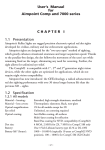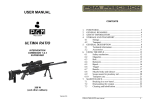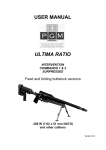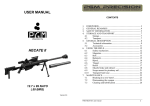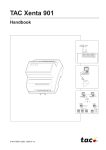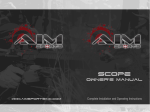Download Field Guide
Transcript
2.1.3 Installing the Rubber Cover on CompM3 and ML3 NOTE: The Rubber Cover (10) shall be mounted to the CompM3 and ML3 after the sight has been installed in the ring. a.Remove the lens covers (front and rear). b.Put the front part of the sight into the lower opening of the Rubber Cover (10) and pull it backwards over the rear part of the sight. Be careful not to pull too hard and far, the Rubber cover (10) could be destroyed (fig. 4) . c.Re-install the lens covers (8) and (9). d.When removing the Rubber cover (10) from the sight, do the opposite: Start by gripping the lower the rear part of the Rubber cover (10) and pull it upwards and forward, off the sight. 2.2 OPERATING PROCEDURES 2.2.1 Zeroing Aimpoint’s sights are delivered in a centered position. Normally this means that only small adjustments are necessary, providing that the base(s) are properly aligned. CAUTION: Do not continue to adjust windage and elevation mechanisms if you encounter resistance. The elevation Adjustment screw is located on top of the sight, while the windage screw is located on the right or left side, depending on how the sight has been mounted on the weapon. Aimpoint sights can be installed to support either right hand (fig. 2) or left hand (fig. 3) shooters. a.Open Front and Rear Lens covers (9) and (8). b.Turn the Rotary switch (4) clockwise until the red dot has a sufficient intensity to contrast against target. c.Insert adjustment tool (coin, screwdriver, knife) or cartridge casing in Adjustment screw slot (7) and turn as follows: NOTE: Each click of the Adjustment screws (7) corresponds to a 13 mm movement of the point of impact at 80 meters, (4 mm at 25 meters, 16 mm at 100 meters and 32 mm at 200 meters or 1/4” at 50 yds, 1/2” at 100 yds and 1” at 200 yds) • To move the point of impact to the right, turn windage adjustment screw counter clockwise (clockwise if screw located on left side). • To move the point of impact to the left, turn windage adjustment screw clockwise (counter clockwise if screw located on left side). • To move the point of impact up, turn elevation adjustment screw counter clockwise. • To move the point of impact down, turn elevation adjustment screw clockwise. d.Confirm zeroing by firing at least three shots at a zeroing target. Check impact points on zeroing target to confirm accuracy and repeat above procedure if required. e.After initial firing, ensure that the mount and sight are secure. f. Turn Rotary switch (4) to OFF position (counter clockwise). g.Close front and rear Lens cover (9) and (8). CHAPTER III – OPERATION UNDER EXTREME CONDITIONS CHAPTER IV – TROUBLE SHOOTING PROCEDURES a.Extreme heat (moist or dry): No special procedures required. b.Extreme cold: Extreme cold might shorten battery life. Keep spare batteries in your inner pockets to keep them warm. c.Salt air: No special procedures required. d.Sea spray, water, mud and snow: Ensure that the Battery cap (2) and the two Adjustment screw caps (5) are tight before exposing the sight to sea spray, mud, snow or before submersing the sight into water. Hand tighten only. Keep Lens covers (8) and (9) closed when the sight is not being used. Clean lenses with lens paper/cloth and wipe the sight dry as soon as possible after exposure to water, sea spray, mud or snow. e.Dust storms and sand storms: Keep Lens covers (8) and (9) closed when the sight is not being used. f. High altitudes: No special procedures required. CAUTION: The lenses shall never be cleaned with fingers but with lens paper/cloth. If lens paper/cloth is not available: 4.1 RED DOT DOES NOT APPEAR –– To clear away debris (sand, grass etc): blow away the dirt or rinse with clear water. –– To clean lenses: mist up the lenses or rinse with clear water and clean them with a soft piece of cloth. Discharged battery: Replace Battery (3) Battery installed incorrectly: Remove and reinstall Battery (3) with (+) toward Battery cap (2). Battery is not making good contact: Clean contact surfaces and reinstall Battery (3). Defective rotary switch: Notify dealer/armourer User Manual for Aimpoint CompM3™ and Aimpoint CompML3™ 4.2 IMPOSSIBLE TO ZERO Adjustment screw is at its limit: Check alignment of mount to barrel Impact point is moving: Check mount stability CHAPTER V – MAINTENANCE a.This reflex sight does not require any particular maintenance while used under normal conditions. b.Under severe weather conditions please refer to CHAPTER III. c.Keep Lens covers (8) and (9) closed whenever the sight is not in use. d.Warehouse storage: Remove Battery (3) and allow lens surfaces to dry completely (if wet) before closing the Lens covers (8) and (9). e.To clean lenses refer to CAUTION in CHAPTER III. f. To reach maximum protection level for all weather conditions, wax is added into the rubber mixture. The wax will slowly migrate to the surface of the part. During frequent use this wax will be used up completely and not noticed by he user. For long time storage, the wax will not be used up as frequently and will be seen as a grey film on the surface. To restore to its original condition, please hand wash in warm dishwater. Aimpoint AB Jägershillgatan 15 SE- 213 75 Malmö, Sweden Phone +46 (0)40 671 50 20 Fax +46 (0)40 21 92 38 e-mail: [email protected] www.aimpoint.com Aimpoint Inc. 14103 Mariah Court Chantilly, VA 20151-2113, USA Phone +1 703-263-9795 Fax +1 703-263-9463 e-mail: [email protected] www.aimpoint.com © Copyright 2015 . Contents property of Aimpoint. All rights reserved. [11432-4] CHAPTER I – PRESENTATION 1.2 SPECIFICATION 1.3 LOCATION AND DESCRIPTION OF MAJOR COMPONENTS 1.1 PRESENTATION Material – housing: Extruded, high strength aluminum, anodized Material – rubber cover: Chloroprene rubber (MIL-R-6855) Material – lens covers: Thermoplastic elastomer, black, non-glare Surface finish: Hard Anodized, Dark Graphite Grey, matte Rubber cover: Black or Dark Earth Brown Optical magnification: 1X Eye relief: Unlimited, no centering required Optical coating: Anti Reflex coating, all surfaces, Multi-layer coating for reflection, Band Pass coating for NVD* compatibility (CompM3) Dot size: 2 and 4 MOA** dot brightness: CompM3: 10 positions: 4 NVD, 6 daylight settings of which 1 Extra Bright CompML3: 10 positions: 1 Off, 9 daylight of which 1 Extra Bright Battery: One 3V Lithium battery type 2L76 or DL1/3N Battery life*** (hours): 50 000 h on setting 7 of 10, Typically 500 000 h at NVD setting. Length (incl. lens covers): 130 mm (5.1”) Width: 62 mm (2.4”), incl rubber cover, 49 mm (1.9”) without Height: 58 mm (2.3”), incl rubber cover, 49 mm (1.9”) without Weight: 270 gram (9.5 oz), incl rubber cover, 220 gram (7.8 oz) without Adjustment: Range ±2 m at 100 meters, in windage and elevation 1 click = 13 mm at 80 meters = 16 mm at 100 meters = 1/2” at 100 yards. Mounting: One wide ring, 30 mm, or Aimpoint QR Ring Max temperature range: -45 ºC to +70 ºC (-50 ºF to +160 ºF) Water resistance: Submersible to 45 m (135 ft) water depth See Fig. 1 Aimpoint’s Reflex Sights are rugged precision electronic optical red dot sights developed for civilian, military and law enforcement applications. Aimpoint sights are designed for the ”two eyes open” method of sighting, which greatly enhances situational awareness and target acquisition speed. Thanks to the parallax-free design, the dot follows the movement of the user’s eye while remaining fixed on the target, eliminating any need for centering. Further, the sight allows for unlimited eye-relief. The CompM3 is compatible with 1st , 2nd and 3rd generation night vision devices, while the CompML3 is optimized for applications, which do not require night vision compatibility. The CompM3 and CompML3 sights are using the revolutionary Advanced Circuit Efficiency Technology, ACET. ACET combines Aimpoint’s superior accuracy and ease of use with significantly low power usage. *NVD: Night Vision Device **MOA: Minute Of Angle 1MOA ≈ 30 mm at 100 meters ≈ 1” at 100 yards ***Average values, depending on brightness setting CHAPTER II – OPERATION UNDER NORMAL CONDITIONS 2.1 ASSEMBLY AND PREPARATION FOR USE Comp M3/ML3 9 2 3 5 Right-handed shooter configuration Left-handed shooter configuration WARNING: Ensure that the weapon is unloaded and the safety selector is in the ”safe” position before attempting to install, remove or perform maintenance on the sight. 2.1.1 Installing Battery 8 a.Remove Battery cap (2) by turning it counter clockwise. b.Insert Battery (3) with positive (+) end toward Battery cap (2). CAUTION: When replacing battery check that the O-ring is present and not damaged. Failure to do so could result in water leakage into the battery compartment. 10 6 7 Fig. 2 1 7 4 Fig. 3 5 2.1.2 Installing Ring and Sight on the weapon Aimpoint’s sights are designed for installation on most types of weapons. If your weapon does not have or support an appropriate base(s), please consult your dealer, gunsmith or other qualified source. Installing the Rubber Cover (RIGHT-HANDED SHOOTER CONFIGURATION ONLY!) 6 1. Sight 2. Battery Cap 3. Battery (DL1/3N or similar) 4. Rotary Switch 5. Cap Adjustment (2 pcs) 6. Rubber Strap (2 pcs) 7. Adjustment screws for elevation/windage (2 pcs) 8. Lens Cover, rear 9. Lens Cover, front 10. Rubber Cover c.Install Battery cap (2) by turning clockwise until snug. Hand tighten only. Using tools could damage equipment. d.Verify that red dot is present by turning the Rotary switch (4) clockwise. a.Assemble the sight to the weapon by using Aimpoint’s wide 30 mm ring or QR-mount. If other standard 30 mm rings are used, make sure that the ring(s) covers a length of minimum 25 mm or 1”. b.Ensure that the sight is correctly positioned for right or left hand shooting. See (fig 2) and (fig. 3). NOTE: Installing the Rubber cover (10) requires right-handed shooter configuration (fig. 2). Fig. 1 c.When using lens covers, ensure that they are correctly positioned and can be opened. NOTE: make sure that you have space between the bottom front part of the sight and the top of the base/weapon. Fig. 4 Fig. 5 d.Finally, make sure that all screws are firmly tightened around the sight. e.Complete zeroing according to (2.2.1).















